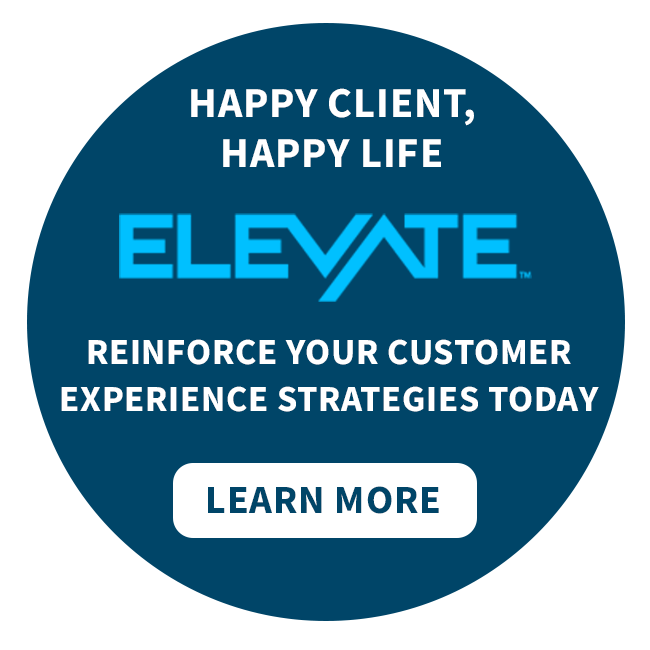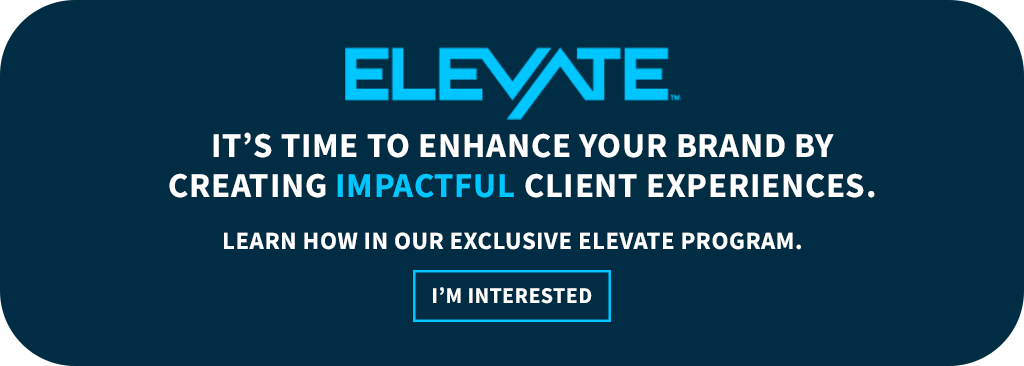Scale your business, build relationships with your clients, and create lasting partnerships by developing a solid customer experience strategy.
A client’s experience is all about perception. Even in everyday situations, such as picking up your morning coffee, our interactions with others can make or break our feelings towards certain people, businesses, and even the products they provide.
Your favorite coffee shop may not deliver the best cup of coffee ever to exist. Still, you keep going back because of the interactions you’ve had, the services provided, and the relationship that was built based on the feelings curated within your experiences there.
If this is true even in situations that deal with a $3 cup of joe, it’s even more so important to come up with a sound and resilient customer experience strategy to implement when dealing with more high-stakes products and services – as a financial professional, your client must trust you.
A customer experience strategy is an essential tactic to put in place to build mutually beneficial relationships with clients, maintain client loyalty, and curate a positive perception surrounding your business. When it comes to a positive customer experience, it’s crucial to understand your client’s wants and needs and, most importantly, their value. You may be delivering valuable services to them. Still, your mindset should be shifted to your client being the most valuable asset and how you should deliver that notion.
A customer experience strategy is precisely what it sounds like – a strategy focused on creating the most positive, memorable, and high-quality customer experience with your brand possible. Without a customer experience strategy, important aspects of a brand-client relationship may fall through the cracks. A whopping 89% of customers state that they’d switch brands after an unpleasant experience and that customer experience makes up around 60% of what people believe is brand loyalty.
Looking at some more eye-widening statistics, around 89% of businesses compete against one another, not based on the services they offer, but based on their customer experience. A primary reason for this is that 73% of customers say that customer experience is a main deciding factor for them when making purchasing decisions. With this knowledge, it’s important to strengthen your strategies to provide your client with the best experience possible.
Personalization of Individual Clients – Say Yes
Setting yourself apart from your competition starts with differentiating the content that you produce. Gone are the days of mass emails – the customer focus has shifted to personalization. Everyone wants to feel special, valued and seen, and this shows true when it comes to the creation of marketing content.
A client will feel much more inclined to engage with personalized content past their name; in fact 49% of people say that they’d engage frequently and be loyal to a company if they were engulfed in a personalized experience. Three examples of easily implementable strategies:
- Engaging Email Content: Add dynamic visual content to your emails, including clickable buttons, in-email surveys, and appointment-setting additives, and update your “from” name – no one can or wants to respond to a “no-reply” or “automated” address.
- Take it Offline: Exit out of email, close the laptop, put down the phone, and watch your client relationships blossom. Face-to-face communication helps to build trust and strengthen relationships between you and your client. Wants and needs are more easily communicated, opening the floor for more productivity and collaboration. Explaining the process or solution being implemented opens conversation and can increase feelings of trust, understanding, and personalization.
- Opt-In to Opt-Ins: Giving the option to receive marketing messages, newsletters, or updates to your client not only gives them a sense of autonomy and trust, but it may also bring you a generous number of leads. It’s good practice to include some type of opt-in landing page on your website so visitors can input their email addresses. If an individual finds value in your company, offerings, or website and wants to stay connected this is the perfect place for them to do so. This may also allow you the opportunity to gain valuable information that may lead to new clients.
Related: Email Marketing for Financial Advisors: 9 Easy Tips to Increase Your Conversions
Don’t Be Afraid to Ask: The Power of Surveys
One of the best ways to figure out what areas of your customer experience strategy could be improved is to simply ask. Using data to back your strategy is very important when analyzing whether implementing a piece of strategy is working. You can easily do this by sending out a short questionnaire asking about your client’s experience working with you, if there are any areas to improve on, and what they believe you’re doing well.
Customer experience surveys can help you understand your current strategy standards and give you some insight into your existing audience. When sending out a survey, it’s important to ask as many people as possible to get a much better understanding of your client base.
Don’t feel discouraged if you get feedback that’s other than positive. This is valuable information that will potentially set you apart from your competition as well as build a space where your client feels heard and seen.
After gaining insight into your client’s thoughts and feelings surrounding your current or potential strategies, make sure to thank them for the time and effort they put into giving you feedback. Again, a huge component of client experience strategy is building a trusting relationship between you and your client. If they feel their opinion matters, they may be more willing to continue deepening your relationship.
Be Adaptable, Deliver Value
As the landscape shifts, so do your clients’ needs. Making sure you can deliver the same high-quality service as you adapt to different situations is very important for the longevity of your business.
Placing yourself in the clients’ shoes may help give you a better picture of their pain points, their wants outside of your services and offerings, and allow a space that fosters a sense of collaboration between you and your clientele.
Competitor Analysis: Do it Better
Be sure to continuously research your competitors. Sign up for their newsletter, emails, or updates – even check for website updates. Jot down a set of notes on the experience you, as a “potential client”, had navigating, the information given to you, and intriguing aspects of your encounter with their channels. Then find a way to do it better. Learn from their mistakes.
You know your clients better than anyone else so try and step into their perspective and think about ways to implement new ideas that keeps up with the evolving industry, your competitors, and clients – starting with a bulletproof customer experience strategy.
Related: Digital Marketing for Financial Advisors: It’s Time to Take On the 2023 Trends
The Perfect Recipe for Connection: Conversational, Informative, & Educational
You’re an expert in the field. Guide your client without being pushy – create partnerships that are based on valuable mutuality.
Customers who experience positive emotional connections with your brand are six times more likely to become a repeat client and 12 times more likely to recommend your services to their personal network. Those are some large statistics that should be considered when building your portfolio of customer experience strategies.
Your products and services don’t define your brand, the interactions and connections made behind the scenes are what can make or break your business when it comes to loyal clients. But how do you emotionally connect with them?
You remain conversational in your communication, you’re informative and knowledgeable about the offerings you provide, and you respectfully educate your audience on happenings in the industry. If you’re easily approachable, viewed as a bank of knowledge, while also remaining relatable, you’ll be golden!
Here are three tips to connect with your clients:
- Meet Them Where They Are: Everyone has different ways of communicating. It’s always a good idea to take time to understand your client, the way that they converse, and meet them there. If they communicate formally, then take on a more formal way of speaking. At the same time, if conversations grow tense, make sure to stay calm and collected to diffuse if necessary.
- Time is Ticking: We all know how uncomfortable those awkward pauses are during a conversation, don’t let your customers feel the same way when in communication with you. Make sure to reduce your response time when it comes to answering calls, responding to emails, and being on time to meetings. When pauses are taken throughout the communication process, the conversation feels less like a chat and more like a formal letter-to-mailbox exchange – it loses the personality your communication processes should embody.
- You’re in This Together: You should approach every conversation, challenge, or problem-solution scenario as if you and the client are working together to solve it. You may have the solution in hand, but it should be a more dynamic process. Use language such as “we” rather than “you” to ensure working together feels like a partnership rather than a disconnected tutorial.
Happy Client, Happy Life!
When clients come to you for business, they want to extract value. Of course, that value may be from the products and services they wish to receive from you, but at the same time, value is linked to the feelings of satisfaction, validation, and working as a team unit. Imploring these strategies will strengthen your existing client relationships and open the floor to building new, streamlined relationships with potential clients.
Take the time to get to know your clients and work to understand them. Recognize how they think, communicate, and go about their processes, and find ways to make that process even more seamless. At the end of the day, it’s all about the delivery of information and how to make that delivery with the most significant impact and most efficiency – and it starts with you.
Keep Reading: Client Segmentation for Wealth Management Firms [Tips to Get Started]
THIS INFORMATION IS DESIGNED FOR USE BY LICENSED INSURANCE AND FINANCIAL SERVICES PROFESSIONALS – NOT FOR CUSTOMER USE



